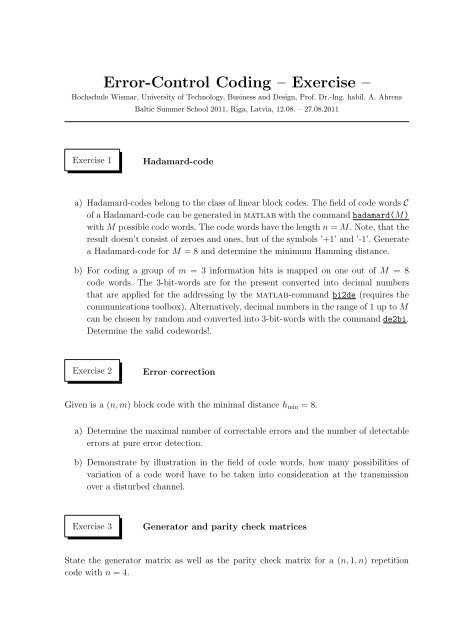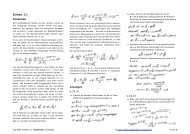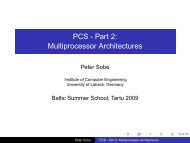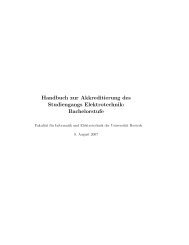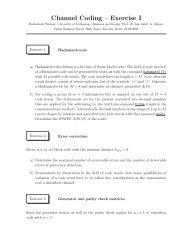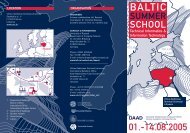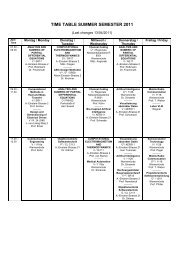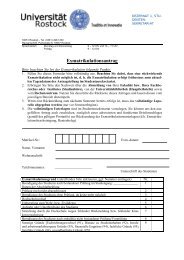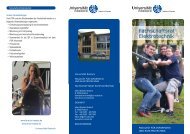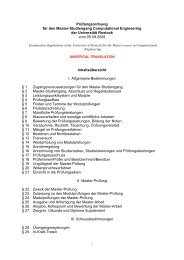Error-Control Coding â Exercise â
Error-Control Coding â Exercise â
Error-Control Coding â Exercise â
Create successful ePaper yourself
Turn your PDF publications into a flip-book with our unique Google optimized e-Paper software.
<strong>Error</strong>-<strong>Control</strong> <strong>Coding</strong> – <strong>Exercise</strong> –<br />
Hochschule Wismar, University of Technology, Business and Design, Prof. Dr.-Ing. habil. A. Ahrens<br />
Baltic Summer School 2011, Riga, Latvia, 12.08. – 27.08.2011<br />
<strong>Exercise</strong> 1<br />
Hadamard-code<br />
a) Hadamard-codes belong to the class of linear block codes. The field of code words C<br />
of a Hadamard-code can be generated in matlab with the command hadamard(M)<br />
with M possible code words. The code words have the length n = M. Note, that the<br />
result doesn’t consist of zeroes and ones, but of the symbols ’+1’ and ’-1’. Generate<br />
a Hadamard-code for M = 8 and determine the minimum Hamming distance.<br />
b) For coding a group of m = 3 information bits is mapped on one out of M = 8<br />
code words. The 3-bit-words are for the present converted into decimal numbers<br />
that are applied for the addressing by the matlab-command bi2de (requires the<br />
communications toolbox). Alternatively, decimal numbers in the range of 1 up to M<br />
can be chosen by random and converted into 3-bit-words with the command de2bi.<br />
Determine the valid codewords!.<br />
<strong>Exercise</strong> 2<br />
<strong>Error</strong> correction<br />
Given is a (n, m) block code with the minimal distance h min = 8.<br />
a) Determine the maximal number of correctable errors and the number of detectable<br />
errors at pure error detection.<br />
b) Demonstrate by illustration in the field of code words, how many possibilities of<br />
variation of a code word have to be taken into consideration at the transmission<br />
over a disturbed channel.<br />
<strong>Exercise</strong> 3<br />
Generator and parity check matrices<br />
State the generator matrix as well as the parity check matrix for a (n, 1, n) repetition<br />
code with n = 4.
<strong>Exercise</strong> 4<br />
Modification of linear block codes<br />
A (5, 4) linear block code is constructed by adapting a (7, 4) block code. The (7, 4) code<br />
can be described by the following generator matrix<br />
⎛<br />
⎞<br />
0 1 0 1 1 0 0<br />
G = ⎜ 1 0 1 0 1 0 0<br />
⎟<br />
⎝ 0 1 1 0 0 1 0 ⎠ .<br />
1 1 0 0 0 0 1<br />
a) Construct the codewords of the (5, 4) code and list them!<br />
b) What is the minimum distance of the (5, 4) code!<br />
<strong>Exercise</strong> 5<br />
Syndrome decoding<br />
a) State the number of syndromes of the (7, 4, 3)-Hamming code and compare it with<br />
the number of correctable error patterns.<br />
b) The word d = (1 1 0 1 0 0 1) is found at the receiver. Which information word i was<br />
sent with the greatest probability?<br />
<strong>Exercise</strong> 6<br />
<strong>Coding</strong> program<br />
Write a matlab-programm which codes and again decodes a certain number of input<br />
data bits. Besides it shall be possible to insert errors before the decoding. The (5, 2, 3)<br />
code shall be used.<br />
Hint: The (5, 2, 3) code maps m = 2 information symbols onto n = 5 code symbols.<br />
Within the matlab-program, m information symbols are randomly chosen using randint<br />
and encoded by the generator matrix. A randomly determined error vector is added and<br />
the syndrome is calculated. Please notice: all calculations have to be executed within<br />
GF (2).


